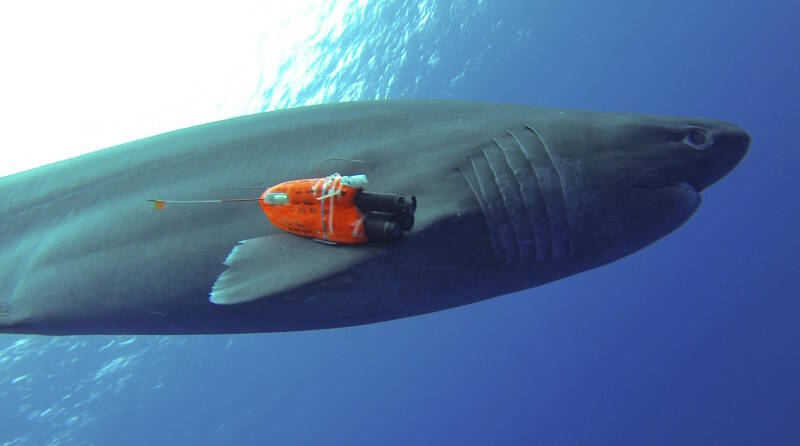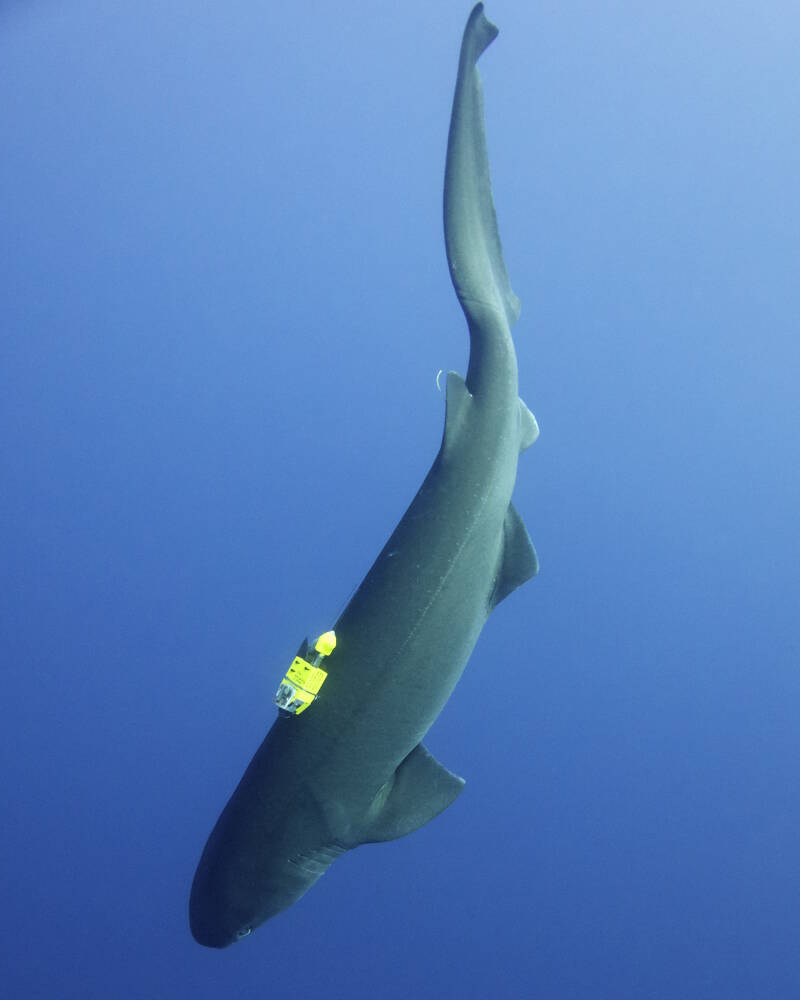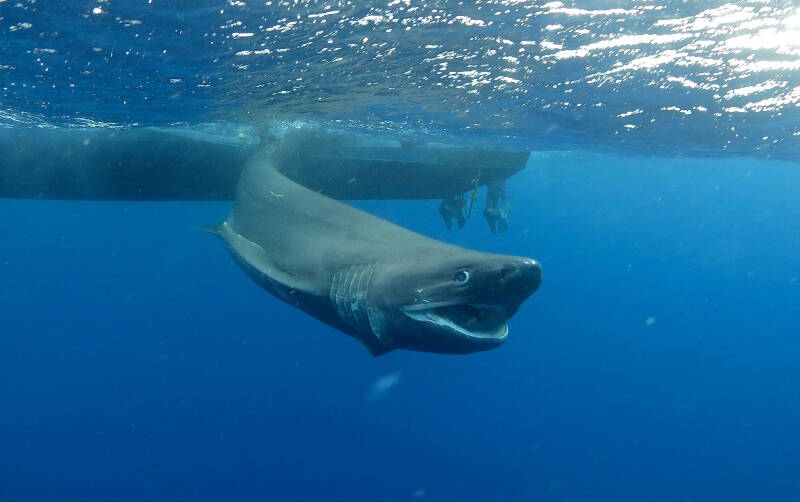
By Mark Royer
Danny Coffey
Hawaii Institute of Marine Biology, University of Hawaii
March 18, 2017
On March 10, 2017, the second dive of the expedition, two sixgill sharks are seen swimming together. Scientists were able to tell that the sharks were a male and female pair. Video courtesy of the NOAA Office of Ocean Exploration and Research, Discovering the Deep: Exploring Remote Pacific MPAs. Download (mp4, 16.4 MB).
At the start of the remotely operated vehicle (ROV) dive at Pao Pao Seamount on March 10, scientists got incredible footage of two adult bluntnose sixgill sharks swimming together at a depth of 500 meters.

A bluntnose sixgill shark is tagged with an accelerometer/magnetometer camera logger by Dr. Carl Meyer and Dr. Itsumi Nakamura off Hawaii. Image courtesy of Mark Royer, Hawaii Institute of Marine Biology, University of Hawaii. Download larger version (jpg, 262 KB).
As their name implies, sixgill sharks are distinguished by their six pairs of gills, whereas most sharks have only five pairs. Bluntnose sixgill sharks (Hexanchus griseus) belong in the order Hexanchiformes that is comprised of the most primitive species of sharks. The overwhelming majority of shark species in this order exist only in the fossil record and only six species still exist today. These species share very similar body characteristics to fossils from the Jurassic period 201 to 145 million years ago, despite the occurrence of two mass extinction events that have occurred since that time.

A bluntnose sixgill shark swims down after being tagged with a multi-instrument tag package by Danny Coffey and Mark Royer at the Hawaii Institute of Marine Biology to study their movement and energetics relative to the oxygen and temperature of their environment. Image courtesy of Mark Royer, Hawaii Institute of Marine Biology, University of Hawaii. Download larger version (jpg, 2.3 MB).
The bluntnose sixgill is the largest member of their order, with males reaching lengths of 12 feet and females reaching lengths of 18 feet. As noted by the Okeanos crew, one of the sharks was identified as a male by the presence of claspers, the copulatory organs that all male elasmobranchs (sharks, skates, and rays) possess. The larger of the two sharks was a female and appeared to be pregnant. Female bluntnose sixgill sharks give live birth to large litters, ranging from 40 to 110 pups.
Bluntnose sixgill sharks are found around the world on continental shelves, slopes, islands, seamounts, and mid-ocean ridges. They live in deep, cold waters between 200 to 1,000 meters in tropical and temperate waters but can be observed in shallower waters (~15 meters) in colder environments such as Puget Sound or Vancouver Island in the Pacific Northwest. While these sharks have been observed and studied in shallower habitats in high latitudes, less is known about their behavior in deep habitats.

A sixgill shark is released after tagging in deep waters off Kaneohe, Hawaii. Image courtesy of Mark Royer, Hawaii Institute of Marine Biology, University of Hawaii. Download larger version (jpg, 1.8 MB).
Tagging studies off Hawaii have shown that sixgill sharks exhibit diel vertical migration, staying in deeper depths of around 600 meters during the day and then moving to shallower depths around 200 meters by night. Diel vertical migration is a widespread phenomenon in marine communities where smaller organisms, such as zooplankton, fishes, and squids, migrate to greater depths during daylight hours to avoid visual predators in shallow waters and return to shallower depths at night to feed. Some larger predators exhibit diel vertical migration as they track the abundance of migrating prey organisms; however, the reasons why bluntnose sixgill sharks undergo diel vertical migration remains a mystery.
Deepwater sharks such as the bluntnose sixgill and prickly shark (Echinorhinus cookei) are slow, sluggish swimmers as you can see in the ROV videos. A recent tagging study using tri-axial accelerometers to record fine-scale body movements has shown that bluntnose sixgill sharks and prickly sharks are positively buoyant. The oil-filled livers of sharks help give them buoyancy, but most sharks are still negatively buoyant in water and most rely on the lift generated by their fins while moving through the water to keep them from sinking. Positive buoyancy allows deepwater sharks to simply glide upward in the water to reach shallower depths when they migrate each night.
In order to better understand the ecological role of large deepwater sharks such as the bluntnose sixgill, more information must be gathered on their behavior and life history. Observations of these species in deepwater habitats around seamounts, combined with information gathered from advanced tagging technology, allow us to gain a better understanding of the large predators that inhabit deep habitats in the ocean.